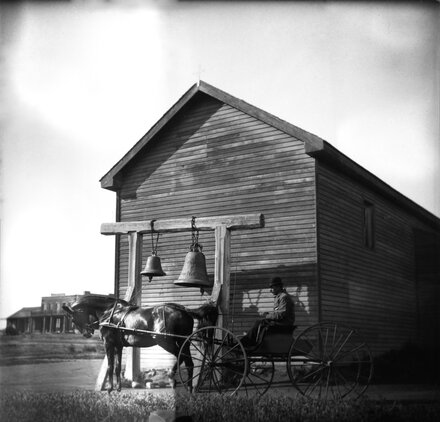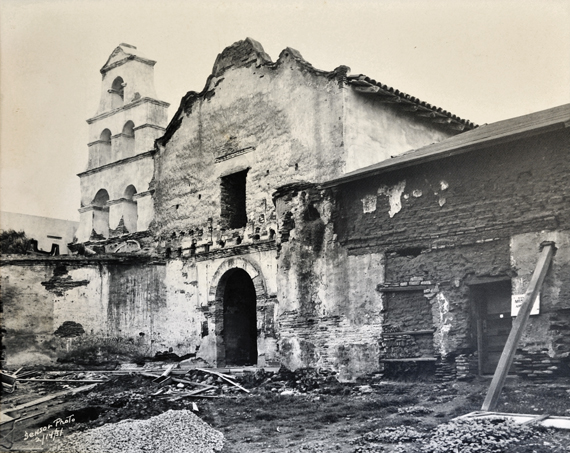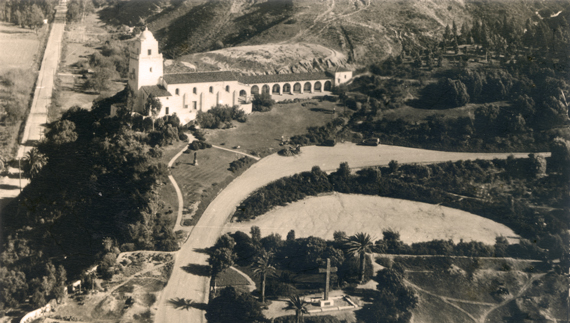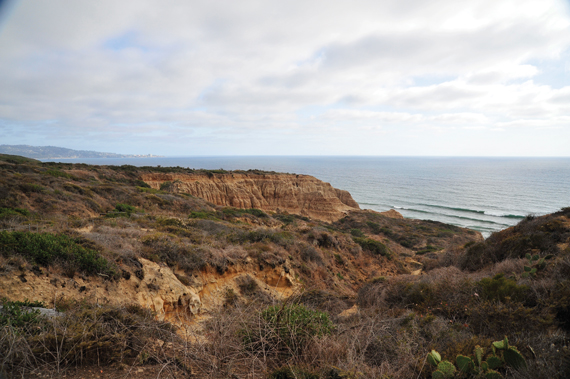|
The Man Who Saw the Future in the Past
George Marston and San Diego’s Preservation Movement
By Alana Coons and Robin Lakin
May/June 2025
 Adobe Chapel in Old Town, c. 1900. Courtesy San Diego History Center |
 Mission San Diego de Alcalá, c. 1900. Courtesy Coons Collection |
 Carrillo-Ruiz Adobe, 1932, purchased and restored by George Marston, standing far left. Courtesy Marston Family Collection |
 Presidio Park and Junípero Serra Museum, c. 1929. Courtesy Coons collection |
 Torrey Pines State Natural Preserve. Photo by Sandé Lollis |
Editor’s note: George White Marston, a kindred spirit to SOHO, dedicated his life to protecting San Diego’s historic places and cultural landscapes. From restoring Old Town’s early buildings to preserving San Diego Mission de Alcalá, Balboa Park, and Presidio Park, Marston embodied the very principles that drive SOHO’s mission today.
Now, SOHO has the honor of preserving and caring for the Marston House, a place that symbolizes his visionary work and our shared belief in the importance of saving San Diego’s historic treasures. Here, during National Historic Preservation Month 2025, we look at just some of his important preservation work.
“In building the city let us remember that the material things which will endure longest are those that express the spirit of man in art. In the arts of landscape and architecture the spirit of a city can be preserved for ages.” - George W. Marston
George W. Marston enjoyed the vast, mercurial scenery at two of the Great Lakes in his native Wisconsin and was familiar with the lives of the peoples native to his birthplace, but he’d never seen the California coastline, an adobe building, or a native ranchería prior to his arrival in this state in 1870.
Intrigued by San Diego’s many-layered, multi-hued history, Marston educated himself on the cultural and natural wonders of his adopted state. He began with the native peoples who had lived here for centuries and continued through the explorers, missionaries, and soldiers who arrived from Mexico in the name of the Spanish Crown, the American colonists fighting for independence and, later, the rugged Forty-Niners seeking gold, absorbing this remarkable sweep of history along the way.
At just 21, Marston was already a preservationist. In 1871, he joined the fight to protect San Diego’s City Park—now beloved, historic Balboa Park—from real estate speculators. Though city officials had reserved the 1,400-acre parkland in 1870, developers covertly enlisted a state senator to introduce a repeal bill. Speculators were the repeal’s strongest supporters, fearing land prices would fall if the parkland stayed public.
News of the underhanded bill quickly reached San Diego, sparking swift action. A “public safety committee,” including Marston, drafted a petition urging the legislature to preserve the park. Within an hour, a dozen canvassers collected 366 signatures. The repeal failed, marking the first major grassroots victory for City Park. Marston would go on to champion Balboa Park’s protection for the rest of his life.
Marston family expeditions to Old Town and the ruins of the Presidio and Mission San Diego de Alcalá, a few miles eastward, were frequent, rewarding pastimes. George’s wife, Anna Lee Marston, described the mission and its grounds this way: “The old adobe of which it is built is crumbling away…the ruins of some of the old dormitories and cells, parts of which are quite perfect. Near the church is a very fine olive orchard…date palms, and some pomegranate trees in full bloom.”
George often traveled to Old Town to visit the old Adobe Chapel and the mission bells hung behind it. According to his daughter Mary, he would stop, “as he always did, to strike the bells with the end of his whip for the pleasure of hearing their beautiful tone.” Climbing the nearby hill to the original Presidio ruins, he could see the unspoiled beauty of the bay.
By the 1890s, Marstonhad become a member of the Landmarks Club of California, founded to preserve the California missions and other historic landmarks. He understood that protecting our local history and conserving the natural landscape would be vital to the city and region’s success. The visionary leader also knew that future development could eradicate San Diego’s rapidly deteriorating historic sites and heritage. So, in 1900, he founded the San Diego chapter of the Landmarks Club to begin stabilizing and restoring the San Diego Mission.
Meanwhile, the Landmarks Club was aiding Father Joseph Jeremiah O’Keefe at Mission San Luis Rey, near Oceanside with its restoration needs.
Marston's preservation ethos had always extended to the conservation of cultural landscapes. He purchased the first acreage for what is now Torrey Pines State Natural Reserve, originally the pueblo lands of the Kumeyaay. Marston, with botanists David Cleveland and Belie Angler, convinced the 1889 City Council to pass an ordinance preserving 364 acres. Philanthropist Ellen Browning Scripps then took the lead and acquired two additional pueblo lots nearby and willed them to the people of San Diego. Today, the exquisite reserve covers 1,500 precious acres of coastal wilderness.
In 1907, the idea of making Presidio Hill a public memorial came from another San Diego leader, Charles Kelly. He was chairman of a committee that studied San Diego roads and boulevards. Kelly recommended that Presidio Hill be set aside as a park, and approached four prominent men who could help: E. W. Scripps, A. J. Spalding, John D. Spreckels, and, a member of his committee, George Marston.
“As the historic importance and the landscaping possibilities of the site grew in father’s mind,” Mary Marston wrote, “he began to buy adjoining property. At an early date he purchased Mr. Kelly’s share. After five years had passed without any inclination on the part of the city to undertake the project, he bought out his three other partners. He saw that the only way in which a worthy memorial could be achieved was for one man to take the responsibility.”
Ultimately, it was indeed Marston who saved the 1769 Spanish presidio, referred to as the “Plymouth Rock of the West," and created Presidio Park.
As the project evolved, Marston realized that preserving only the site of the cross that Father Junípero Serra planted on Presidio Hill wasn't enough. He began acquiring surrounding land, ultimately securing over 40 acres. In 1926, he donated it to the City of San Diego as a park to be preserved in perpetuity. Even in his final year 20 years later, 1946, Marston wrote to city officials urging them to protect Presidio Park’s character and significance.
Presidio Park was meant to shield the nationally important historic site and its ruins from encroaching development. It represents the culmination of Marston’s lifelong mission to preserve San Diego’s heritage and varied landscapes. The park and its Junípero Serra Museum, a building Marston commissioned from San Diego architect William Templeton Johnson, stand as symbols of the Marston family’s profound dedication to history, nature, beauty, architecture, planning, philanthropy, and cultural preservation.
In the 1920s, Marston also turned his attention to Old Town. He restored the crumbling Ruiz-Carrillo Adobe in 1931 and later deeded it to the city for the Presidio Golf Course. In 1932, he enlisted native San Diegan designer Cliff May to restore El Campo Santo cemetery, focusing on rebuilding its adobe wall.
Additionally, he helped secure iconic natural desert landscapes, including Borrego Palm Canyon. In 1928, Marston purchased and donated 2,320 acres in the area, and, with the San Diego County State Parks Committee, added 5,500 more. These efforts laid the foundation for Anza-Borrego Desert State Park, which now spans 640,000 acres and attracts thousands of annual visitors from near and far.
San Diego historian Gregg Hennessey noted that Marston embodied both preservationist and conservationist ideals, and favored cooperation and volunteerism over confrontation. The San Diego Natural History Museum credits Marston’s vision and generosity with inspiring others to become conservationists and environmenalists, and ultimately for creating the vast desert park we cherish today. "We all have a…state park to enjoy because one man stood his ground," Hennessey wrote.
And there is so much more that Marston appreciated and set aside for future residents and visitors alike throughout San Diego County. Agua Hedionda Lagoon, Mount San Jacinto State Park, Palomar Mountain State Park, and the Silver Strand State Beach are among the natural treasures and cultural landscapes that enrich us and contribute to our physical, mental, and spiritual well-being.
All of these and other significant saved sites symbolize Marston and his family’s lifelong work to protect and preserve San Diego, representing their shared values: love of beauty and nature, appreciation of different cultures, historic preservation, and philanthropy. These same principles have been driving SOHO’s mission for nearly sixty years.
Clearly, Marston’s legacy deeply influenced his children and grandchildren. When the time came, his daughter Mary Marston honored it in 1974 by bequeathing the Marston House, along with its historic carriage house and gardens, to the City of San Diego, with the property to be transferred upon her death, in 1987. As the house’s last resident, Mary generously expanded the cultural reach of Balboa Park, as well as that of her family.
Today, SOHO has the honor of preserving, restoring, and stewarding the 1905 Marston House and its gardens, a National Register of Historic Places landmark now celebrating its 120th year.
George Marston was a true visionary and a wise and intelligent man of action. Modest by nature, he always shared credit with the many citizens who worked with and stood beside him—men and women who also helped shape San Diego’s strong future.
For George and other early leaders, historic preservation was a badge of honor. They brought integrity, vision, and a tireless work ethic to illuminating and protecting our region’s heritage and special character. These same values are at the heart of SOHO today, and we are proud to carry on this vital mission.
BACK to table of contents
|
2025
2024
2023
2022
2021
2020
2019
2018
2017
2016
2015
|








